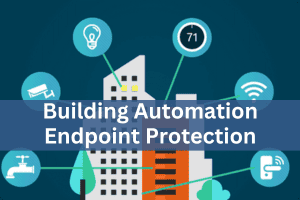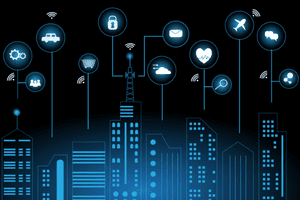The Importance of Cybersecurity Protection for Building Infrastructure

Podcast Outline
Introduction
Understanding Cybersecurity for Building Infrastructure
Real-Time Security: A Necessity
Smart Buildings: Balancing Innovation and Security
Zero Trust Systems: The Future of Cybersecurity
Challenges in Securing IoT Devices
Implementing Secure Firmware Solutions
Conclusion
Podcast Transcript
Introduction
Welcome to another insightful episode of “Protecting Buildings and OT from Cyber Attacks,” where we delve into the ever-evolving world of cybersecurity and its integral role in modern infrastructure. Today, we are addressing a topic that is both timely and essential—cybersecurity protection within the realm of building infrastructure. In an age where technology is omnipresent, safeguarding our digital environments is not just a necessity but a critical priority. This episode promises to unravel the complexities involved in securing our built environments, ensuring they remain resilient against potential cyber threats. We’ll start by exploring the foundation of cybersecurity in building infrastructure. This isn’t just about preventing unauthorized access—it’s about understanding the very architecture of our security measures and how they integrate with operational technologies. As we move through today’s discussion, you’ll gain insights into the vital importance of real-time security measures. In an era where threats evolve instantaneously, having a system that can respond in real time is no longer a luxury but a necessity. Real-time security can mean the difference between a thwarted attack and a catastrophic breach. Imagine, for instance, a smart building’s heating system being hacked during a cold snap—real-time security could prevent such a disaster before it even begins.
Moreover, as we venture into the realm of smart building technologies, the balance between innovation and security becomes apparent. Smart buildings offer unprecedented convenience and efficiency, yet they also present new vulnerabilities. We’ll dissect how these technologies can be both a boon and a bane, urging a careful approach to their implementation. The idea of a building that can think and respond to its environment is certainly appealing, but without adequate security measures, this intelligence could be manipulated by malicious entities. Here, we’ll introduce the concept of zero trust systems, a cutting-edge approach to cybersecurity that insists on verification at every step. Zero trust is poised to be the future of cybersecurity. By the end of our episode, you’ll have a clear understanding of why adopting a zero trust framework is crucial for the future of secure infrastructure.
But what does it truly mean for a system to adopt zero trust, and how can this be realistically applied within the vast landscape of building infrastructure? This episode promises to provide clarity on these questions, equipping you with knowledge to advocate for and implement these systems effectively. We aim to leave you not just informed but empowered to tackle the cybersecurity challenges you may face. Our discussion will also touch upon the challenges inherent in securing IoT devices—a fundamental component of smart infrastructure. These devices, while powerful in their capacity to connect and streamline operations, often lack the robust security needed to fend off cyber threats. Understanding how to implement secure firmware solutions is another cornerstone of today’s episode. By addressing these vulnerabilities, we can create a more secure digital landscape.
So, whether you’re a cybersecurity professional, a building manager, or simply interested in the technological advances shaping our world, this episode is sure to offer valuable insights. As you listen, consider how the principles discussed can be applied to the world around you. Remember, the future of building infrastructure doesn’t just lie in its ability to innovate but in its steadfast commitment to security. Get ready for a deep dive into the intricate and necessary world of cybersecurity in building infrastructure. By the end of our time together, we hope you’ll be inspired to fortify your own digital environments with the tools and knowledge you gain here today. Let’s embark on this journey to understand the profound impact and necessity of cybersecurity in the infrastructures we rely on every day.
Understanding Cybersecurity for Building Infrastructure
In the realm of building infrastructure, understanding cybersecurity is of paramount importance. Cybersecurity protection in this context refers to the comprehensive measures and practices put in place to safeguard the technological components of building systems from malicious attacks and unauthorized access. With the increasing integration of digital technologies into our buildings, the definition of cybersecurity extends beyond mere data protection to encompass the physical safety of the building’s occupants and the integrity of its operations. This involves a multi-layered approach that includes securing communication networks, monitoring system activities, and implementing protocols that ensure only authorized individuals have access to sensitive systems. As buildings become more reliant on interconnected technologies, the need for robust cybersecurity measures becomes evident, not only to protect data but to prevent potential disruptions to the essential services these buildings provide.
As we delve deeper into the integration of Internet of Things (IoT) devices within building infrastructures, it becomes clear that these advancements, while beneficial, significantly increase the need for enhanced cybersecurity measures. IoT devices are integral to modern building management systems, enabling everything from energy efficiency improvements to smart security systems. However, the very attributes that make IoT devices so valuable—such as their connectivity and data-sharing capabilities—also make them vulnerable to cyber threats. This connectivity can serve as a gateway for cyber attackers to infiltrate a building’s network, potentially compromising its systems and data. Therefore, it is crucial to implement robust cybersecurity strategies that can effectively manage and mitigate these risks. These strategies might include network segmentation to isolate vulnerable IoT devices, deploying advanced encryption methods to protect data transmissions, and maintaining stringent access controls to ensure that only authorized persons can interact with critical systems. By understanding and addressing the cybersecurity implications of IoT integration, building operators can not only protect their infrastructure but also ensure the safety and security of their occupants and assets. The evolution of building infrastructure into a more digital realm necessitates a proactive approach to cybersecurity, one that anticipates potential threats and implements solutions before vulnerabilities can be exploited.
Real-Time Security: A Necessity
Real-time security has emerged as a crucial component in the defense against cyber threats, especially within building infrastructures that are increasingly dependent on IoT devices. At its core, real-time security involves the continuous monitoring and analysis of data to detect and respond to security incidents as they occur, rather than after the fact. This proactive approach is vital in preventing unauthorized access and potential breaches, as it allows for immediate action to be taken before an attack can cause significant damage. In a building environment, this could mean detecting an anomaly in a security system’s behavior, such as unexpected access attempts, and swiftly neutralizing the threat. The significance of real-time security lies in its ability to minimize response times and mitigate potential damage by ensuring that security measures are always one step ahead of cybercriminals. As buildings become smarter and more interconnected, the capacity to react in real time not only protects sensitive information but also safeguards the physical environment and its occupants from harm.
However, implementing real-time security in buildings equipped with IoT devices presents a unique set of challenges. One of the primary difficulties is the sheer volume of data generated by these devices, which can overwhelm traditional security systems and make it difficult to discern genuine threats from false positives. Additionally, many IoT devices operate on limited processing power and memory, making it challenging to integrate sophisticated real-time security protocols without impacting their functionality. The decentralized nature of IoT networks further complicates the deployment of uniform security measures, as each device may have distinct security requirements and vulnerabilities. To address these challenges, organizations must adopt innovative solutions that enhance the capabilities of IoT devices while maintaining robust security standards. This might involve leveraging cloud-based security platforms that can process and analyze data at scale, thus alleviating the burden on individual devices. Additionally, the use of machine learning algorithms can help in identifying and predicting potential threats, enabling a more adaptive and responsive security posture. By overcoming these obstacles, real-time security can be effectively implemented to protect building infrastructures, ensuring they remain resilient in the face of evolving cyber threats.
Smart Buildings: Balancing Innovation and Security
The advent of smart buildings represents a significant leap forward in how we manage and interact with our built environments. These buildings are equipped with advanced technologies that enable them to operate autonomously, optimizing energy usage, enhancing occupant comfort, and improving overall efficiency. However, this rise in innovation also brings with it an array of cybersecurity risks that must be carefully managed. Smart buildings rely heavily on interconnected systems and IoT devices, which, while providing convenience and efficiency, also create more entry points for potential cyber threats. These vulnerabilities can be exploited by attackers to gain unauthorized access, disrupt services, or steal sensitive information. Therefore, the challenge lies in balancing the benefits of these cutting-edge technologies with the need for robust security measures that protect against both external and internal threats. It is essential for stakeholders to remain vigilant and proactive, constantly updating and fortifying their cybersecurity strategies to safeguard these intelligent infrastructures.
To effectively protect smart building infrastructure, secure firmware and IoT security SDKs (Software Development Kits) play a pivotal role. Firmware is the foundational software embedded in IoT devices that controls their functions and operations. Ensuring this firmware is secure is crucial, as it acts as the first line of defense against cyber intrusions. Secure firmware solutions include implementing digital signatures and secure boot processes that verify the integrity of the firmware before it is loaded, thus preventing unauthorized modifications. In addition, IoT security SDKs provide developers with the tools and resources necessary to build secure applications and devices. These SDKs include cryptographic libraries, secure communication protocols, and authentication mechanisms designed to protect data and device integrity. By incorporating these security measures, developers can significantly reduce the risk of vulnerabilities in smart building systems. Furthermore, ongoing monitoring and updates are essential to address emerging threats and ensure that the security landscape evolves in tandem with technological advancements. Through a combination of secure firmware and comprehensive IoT security SDKs, stakeholders can create a fortified environment that maximizes the benefits of smart buildings while minimizing their cybersecurity risks.
Zero Trust Systems: The Future of Cybersecurity
The zero trust security model is rapidly gaining traction as a fundamental approach to cybersecurity, particularly within building infrastructure systems. Unlike traditional security models that rely on predefined trust levels for users and devices within a network, zero trust operates on the principle of “never trust, always verify.” This means that every request for access, regardless of its origin, must be authenticated and authorized before it can proceed. In the context of building infrastructure, implementing a zero trust model ensures that all interactions within the system are continually scrutinized, which significantly reduces the risk of unauthorized access and data breaches. By requiring strict identity verification and continuous monitoring, zero trust enhances the security posture of buildings, making it difficult for malicious actors to exploit vulnerabilities. This model is especially relevant as buildings become more digitized and interconnected, necessitating a robust framework that can adapt to complex and dynamic threat landscapes.
Zero trust systems are particularly effective in mitigating risks associated with IoT devices in building infrastructures. IoT devices often lack advanced security features, making them an attractive target for cybercriminals. By applying zero trust principles, each IoT device is required to prove its identity and legitimacy before gaining access to the network or interacting with other devices. This minimizes the potential impact of compromised devices, as any suspicious activity is quickly detected and contained. Additionally, zero trust systems facilitate micro-segmentation, where the network is divided into smaller, isolated segments, which restricts lateral movement by attackers within the network. This means that even if a device is compromised, the threat is confined to that segment, preventing it from spreading throughout the entire infrastructure. The implementation of zero trust not only strengthens the security of individual IoT devices but also enhances the overall resilience of the building’s cybersecurity architecture. As the future of building infrastructure continues to evolve, adopting a zero trust security model will be essential in ensuring that these advancements are protected from an ever-expanding array of cyber threats.
Challenges in Securing IoT Devices
Securing IoT devices within building infrastructure presents numerous challenges, primarily due to the limitations of small IoT processors. These devices are designed to be compact and energy-efficient, often resulting in reduced computing power and memory capacity. Consequently, they struggle to accommodate the robust security protocols typically used in larger systems. Standard security methods, such as encryption and authentication, require significant processing power and memory, which many IoT devices lack. This limitation leaves them vulnerable to unauthorized access and potential exploitation. Furthermore, the diversity of IoT devices, each with varying capabilities and configurations, complicates the implementation of uniform security measures. The challenge for cybersecurity professionals is to design solutions that provide adequate protection without compromising the functionality or performance of these devices. As IoT devices become increasingly integral to building operations, addressing these limitations is critical to maintaining the security and integrity of modern infrastructures.
One promising approach to overcoming these challenges is the use of public-key cryptography, which addresses key management issues inherent in IoT security. Public-key cryptography employs a pair of keys—a public key and a private key—for encryption and decryption, respectively. This method eliminates the need for shared secret keys, which are difficult to manage and secure across numerous devices. By using public-key cryptography, data can be securely transmitted between devices, ensuring that only authorized entities can access sensitive information. However, implementing public-key cryptography on small IoT devices can be resource-intensive, as traditional algorithms like RSA and ECC (Elliptic Curve Cryptography) require substantial computational resources. To mitigate this, researchers are exploring more efficient algorithms and lightweight cryptographic techniques that can be tailored to the constraints of IoT devices. These solutions must strike a balance between security and performance, ensuring that IoT devices can operate securely without being burdened by excessive processing demands. By leveraging advancements in cryptography and tailoring security measures to the specific needs of IoT devices, the cybersecurity community can develop effective strategies to protect building infrastructures from the growing array of cyber threats.
Implementing Secure Firmware Solutions
In the realm of building infrastructure, the implementation of secure firmware solutions is indispensable for protecting against cyber threats. Firmware acts as the foundational software that controls the hardware of IoT devices, making it a primary target for cyberattacks. Its security is paramount, as compromised firmware can lead to unauthorized access and malicious control over device functions. Secure firmware solutions involve the use of cryptographic techniques to ensure the integrity and authenticity of the firmware before it is executed. This includes measures like digital signatures and secure boot processes, which verify that the firmware has not been altered by unauthorized parties. These techniques prevent attackers from injecting malicious code into devices, thereby safeguarding the entire building infrastructure from potential breaches. As IoT devices proliferate within smart buildings, maintaining secure firmware becomes a critical defense mechanism that protects not only data but also the operational integrity of building systems.
A key component of secure firmware solutions is the use of signed firmware and secure boot architectures. Signed firmware involves applying a digital signature to the firmware code, which is then verified by the device’s hardware before the code can be executed. This verification process ensures that only firmware released by a trusted source can run on the device, preventing the execution of any unauthorized or malicious code. Secure boot, on the other hand, is a process that establishes a chain of trust from the hardware up through the firmware and operating system. Each step in the boot process is verified before moving on to the next, ensuring that the system starts in a secure state. This architecture is crucial for maintaining device integrity, as it protects against attacks that target the boot process to gain control over the device. Together, signed firmware and secure boot architectures form a robust security framework that is essential for protecting IoT devices in building infrastructures. By implementing these solutions, stakeholders can ensure that their systems remain secure and resilient against evolving cyber threats, thereby safeguarding the critical operations of modern smart buildings.
Conclusion
As we draw to a close on this episode of “Protecting Buildings and OT from Cyber Attacks,” it’s essential to reflect on the pivotal role cybersecurity plays in safeguarding our building infrastructures. Throughout our discussion, we’ve journeyed through the intricate landscape of cybersecurity, underscoring its significance in protecting not just data but the very essence of our built environments. With the increasing integration of IoT devices and smart technologies, the need for robust cybersecurity measures has never been more critical. These systems form the backbone of our modern infrastructure, ensuring that our buildings remain resilient and secure in the face of potential threats. The conversation we’ve had today highlights not only the challenges but also the innovative solutions that are paving the way for a more secure future. By understanding and addressing these issues, we can better protect our infrastructures and the people who rely on them every day.
I urge each of you, whether you’re an industry professional, a building manager, or simply someone interested in the technological advancements shaping our world, to prioritize cybersecurity in your own projects. The security of our infrastructures is not a responsibility that falls on a single entity but a shared commitment across all sectors involved. As you embark on your endeavors, consider the strategies and insights shared in this episode as a foundation for implementing effective cybersecurity measures. Whether it’s through investing in secure firmware, adopting zero trust models, or ensuring real-time security, each step you take contributes to a safer and more secure environment. Let us not wait for vulnerabilities to be exposed but instead proactively fortify our digital and physical landscapes against the ever-evolving cyber threats. In doing so, we not only protect our assets but also enhance the trust and safety of those who interact with our infrastructures daily.
Thank you for joining us today on “Protecting Buildings and OT from Cyber Attacks.” Your interest and dedication to enhancing cybersecurity in building infrastructures are vital to driving progress and innovation in this field. As we part, let’s remember that the security of our environments begins with each decision we make and each action we take. In the words of cybersecurity experts, “The best offense is a good defense,” so let’s commit to defending our infrastructures with the knowledge and tools at our disposal. We appreciate your time and engagement and hope this episode has provided valuable insights that inspire action. Until we meet again, stay vigilant, stay informed, and continue to protect what matters most.
This podcast was created with with AI using Hubspot ContentHub
—
Blog Post Summary – All of our recent posts listed on one page



